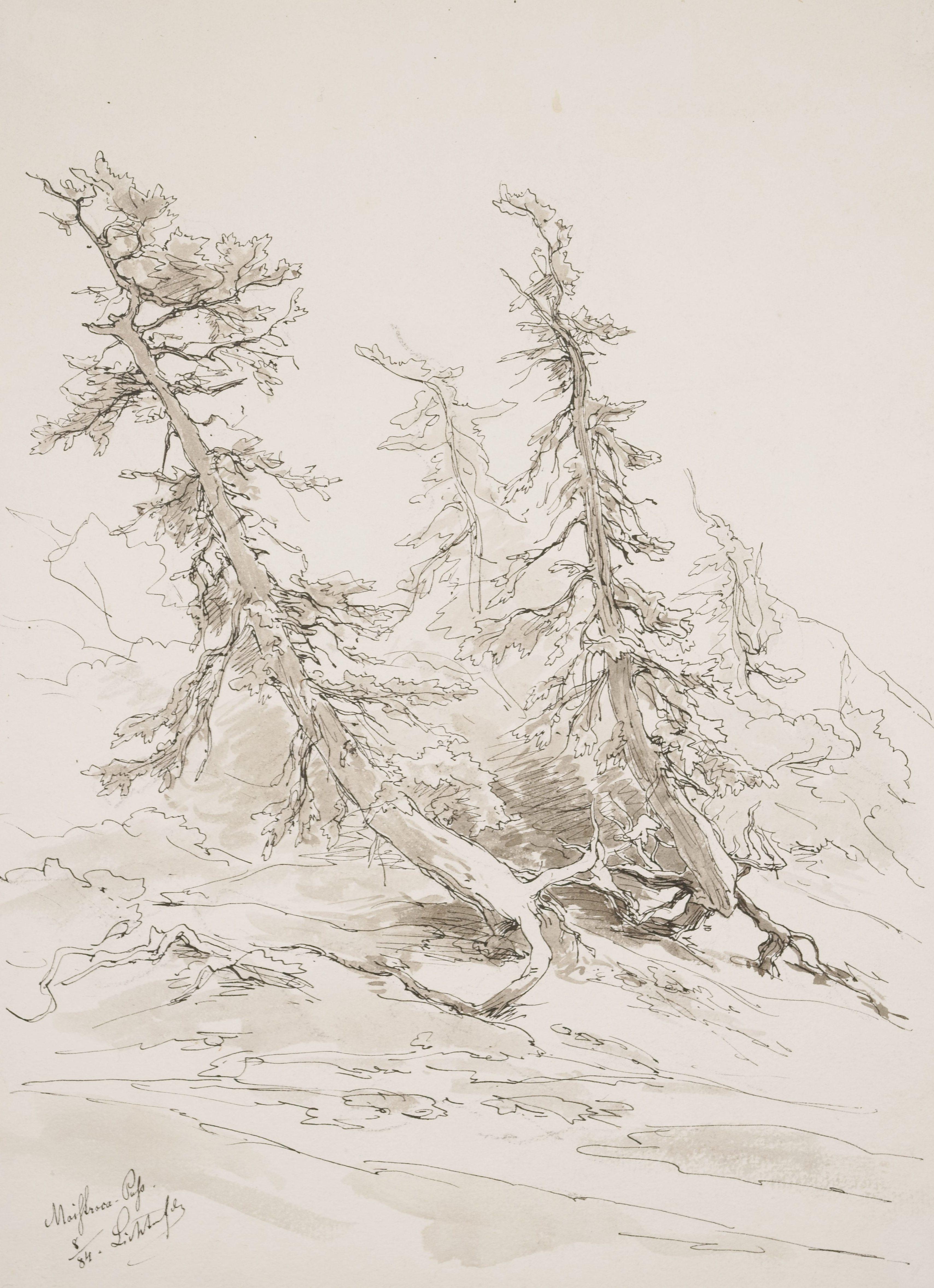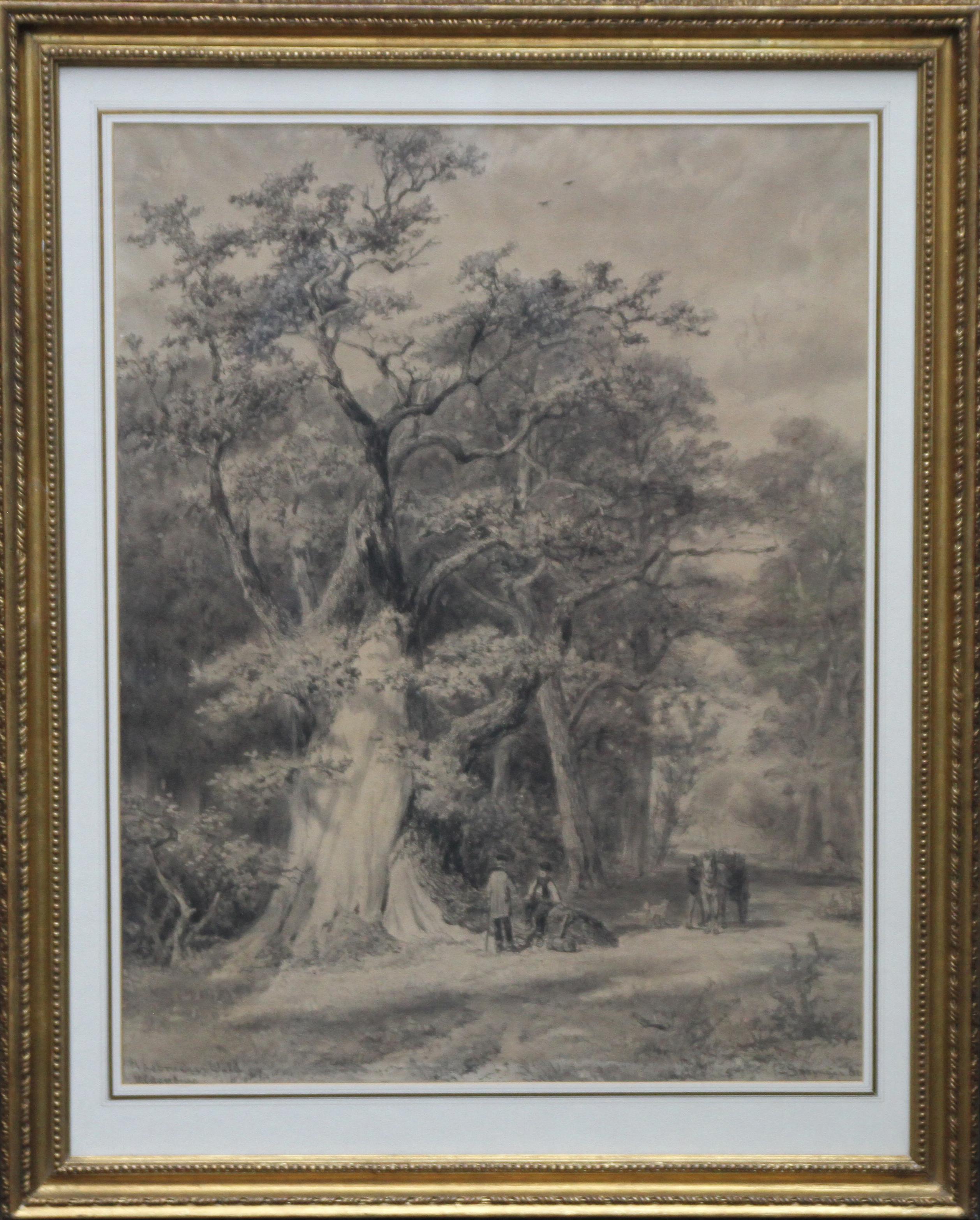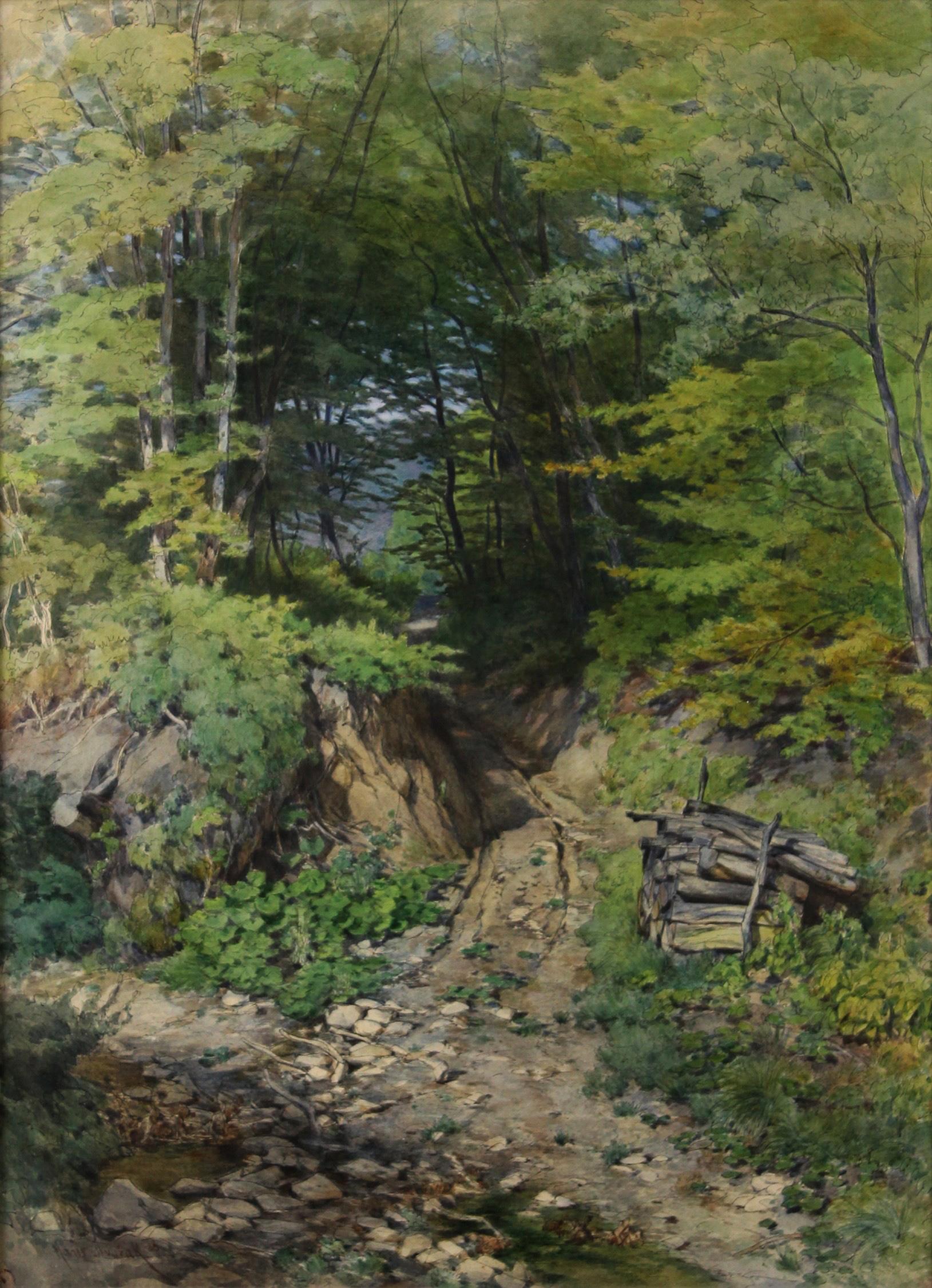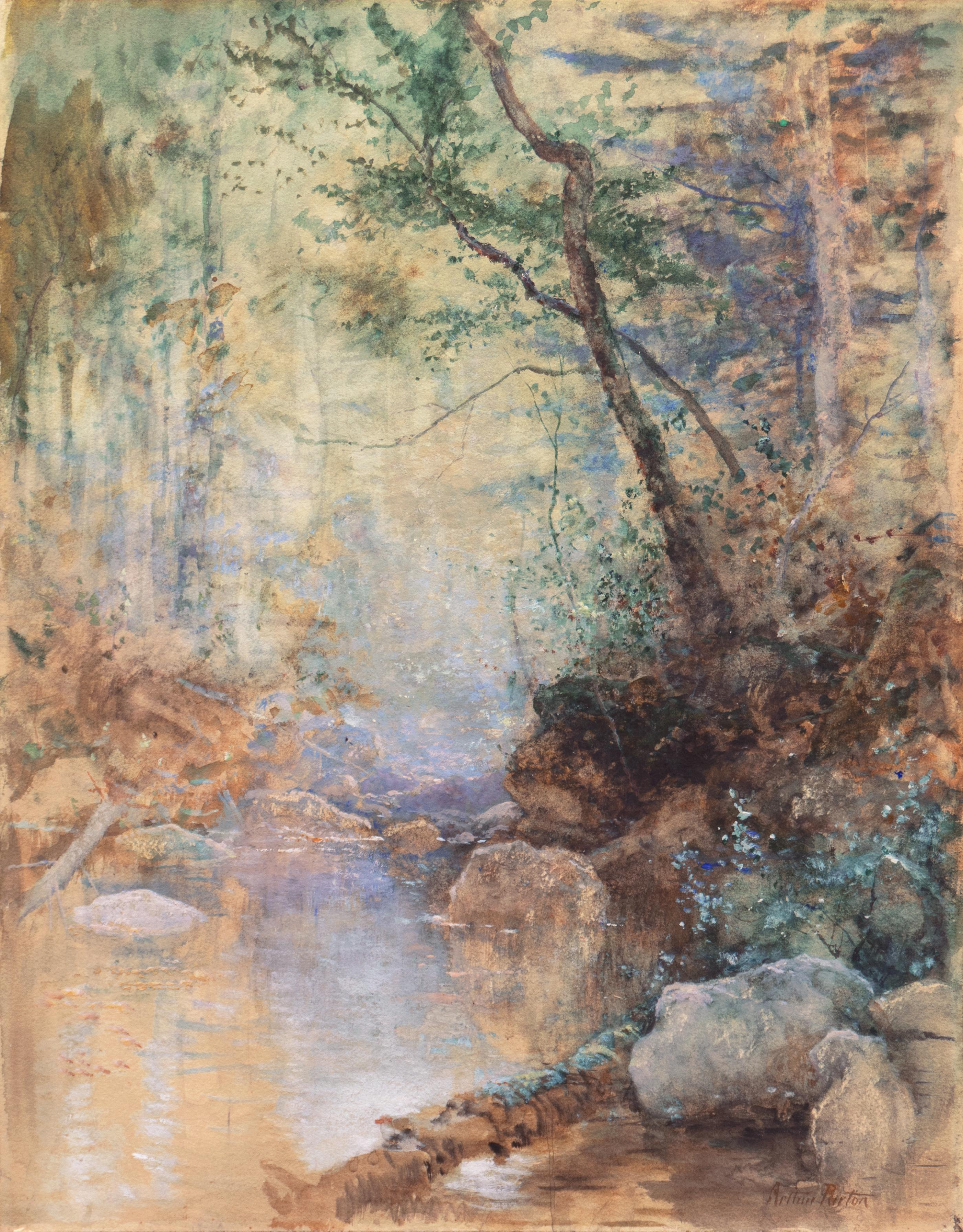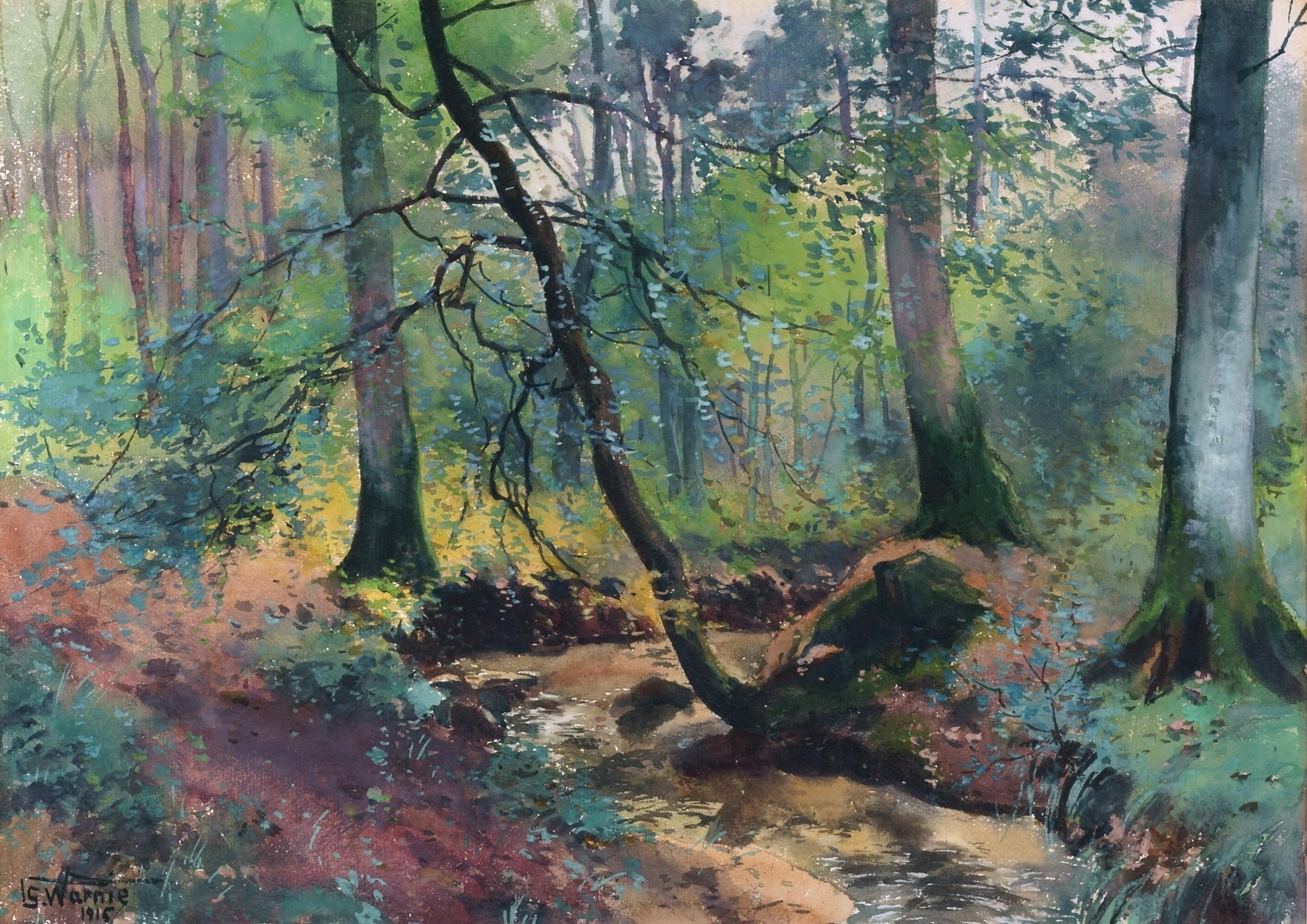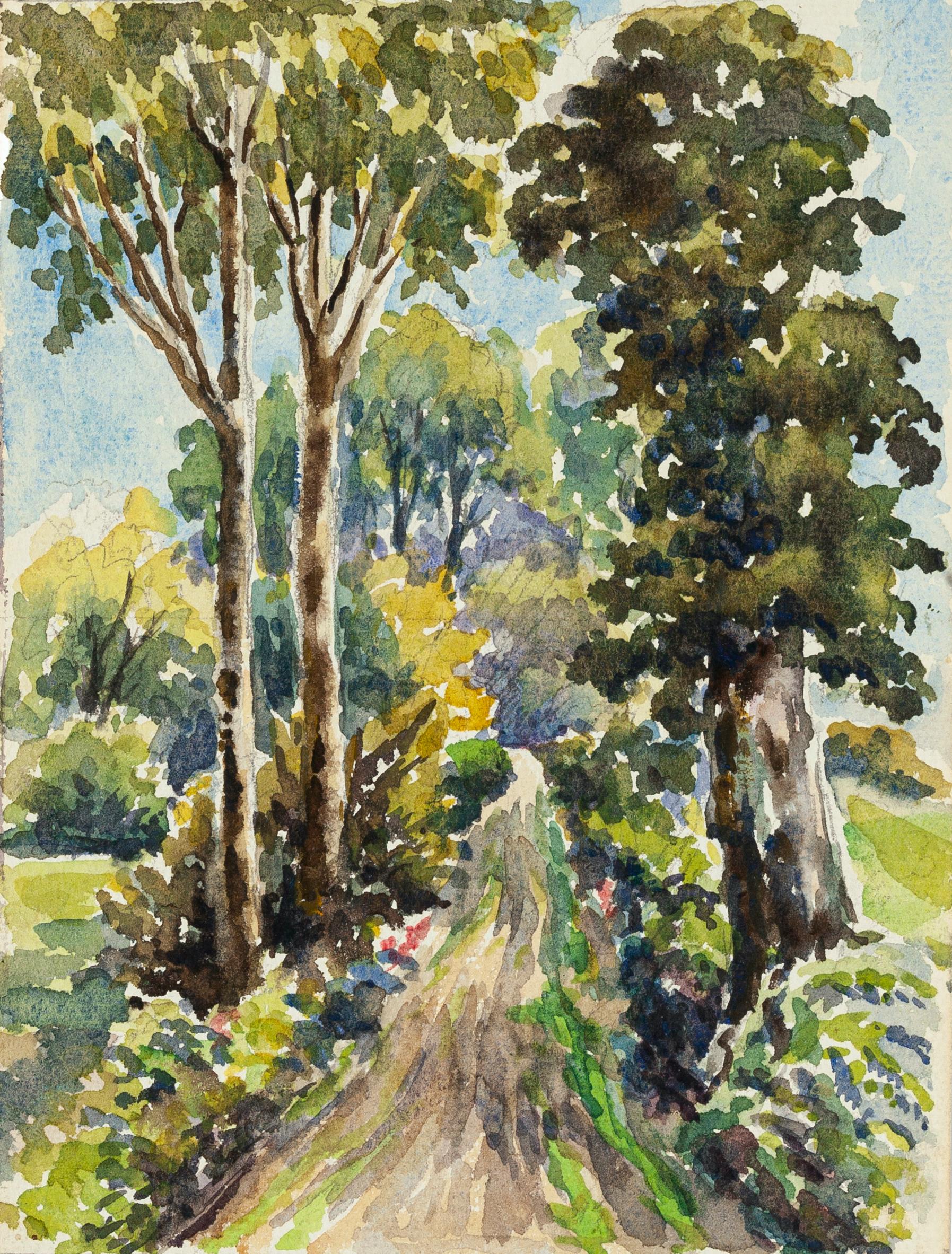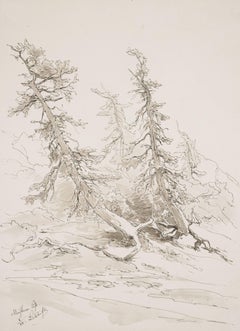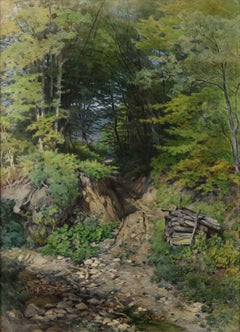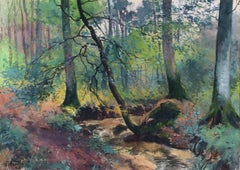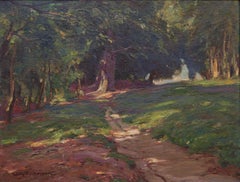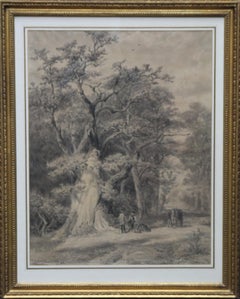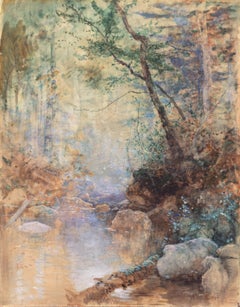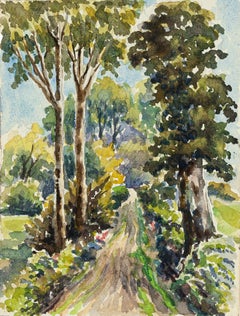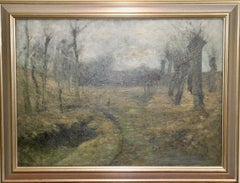Items Similar to In the forest of Durlach - Quiet ripple in a secret place -
Want more images or videos?
Request additional images or videos from the seller
1 of 8
Franz Xaver Gräßel In the forest of Durlach - Quiet ripple in a secret place -1881
1881
$2,237.17
$2,796.4620% Off
£1,687.23
£2,109.0420% Off
€1,920
€2,40020% Off
CA$3,093.08
CA$3,866.3520% Off
A$3,464.77
A$4,330.9620% Off
CHF 1,819.82
CHF 2,274.7820% Off
MX$42,130.50
MX$52,663.1320% Off
NOK 23,044.90
NOK 28,806.1320% Off
SEK 21,875.81
SEK 27,344.7620% Off
DKK 14,616.30
DKK 18,270.3720% Off
About the Item
Franz Xaver Graessel (1861 Oberasbach/Baden - 1948 Emmering). In the forest of Durlach. 1881. Pencil drawing, heightened with white, on grey-green paper. 33 x 41.7 cm. Signed, dated and inscribed by the artist himself: 'Franz Graessel. Durlach, 12 April 1881".
About the artwork
The drawing depicts a view of the woods which, as if sharpening the visual focus, remains diffuse at the edges and does not allow the viewer to locate himself in the picture. As a result, the landscape appears to be an apparition, but at the same time it is given real substance by the solidity of the massive arched bridge made of quarry stone. As the main motif of the painting, the bridge, which blends in with nature like an archaic relic, also acts as a visual guide, drawing attention to the white, raised waters of the stream and the surrounding vegetation. The diffusion of perception that takes place there, however, draws the eye back to the bridge and thus to the overall view. This movement initiating a constant alternation of diffusion and concretion, which is the specific tension of the painting that brings the landscape to life. The materialisation and dematerialisation, however, does not take place solely through the eye's wandering through the picture; it is simultaneously linked to the viewer's approach to and distance from the picture, which loses its richness of detail precisely in the close-up, only to reconfigure itself with increasing distance.
In this work, which dates from Graessel's studies in Karlsruhe, the artist reflects on the emergence of pictorial objectivity. Here, however, nature is more than a mere motif. The real connection between culture and nature is symbolically expressed by the choice of green paper.
The drawing is an impressive testimony to Graessel's mastery of the sprezzatura with which he skilfully applies the most abstract of strokes, which visibly merge towards the centre of the picture. The signature and the exact date prove that Graessel gave this work more than the character of a mere sketch.
About the artist
Franz Graessel grew up in an environment that was to nourish his later key motifs: his parents' house was a mill. After attending the Karlsruhe Academy of Art from 1878 to 1884, where he studied under Carl Hoff, Graessel continued his training at the Munich Academy from 1886 to 1890 as a pupil of Wilhelm von Lindenschmidt. Trained primarily in genre and portrait painting, he initially portrayed the life of Black Forest farmers. From 1894 he turned increasingly to animal painting, concentrating on the depiction of ducks and geese, which earned him the nickname 'Enten-Graessel'. Graessel's work thus parallels that of Alexander Koester (1864-1932), who was also known as 'Duck-Koester'. Koester had begun studying art the year after Graessel left Karlsruhe, also with Carl Hoff, and later, like Graessel, went to Munich. Like Koester, however, Graessel continued to paint portraits and landscapes as well as animals.
In 1900 Graessel turned his back on the big city and moved from Munich to Emmering near Fürstenfeldbruck, where a number of artists who became known as the 'Brucker Maler' settled in Graessel's wake. Due to his national and even international success, Graessel was appointed Royal Academy Professor at the Munich Academy of Fine Arts by Prince Regent Luitpold in 1911. In 1914 the first exhibition of local artists was held in Bruck's town hall, and in 1924 the Fürstenfeldbruck Artists' Association was founded, of which Graessel was honorary chairman.
Graessel was a regular participant in the annual exhibitions at the Glaspalast in Munich, where he often acted as a juror. Franz Hanfstaengel's 'Kunst unserer Zeit' and 'Jugend' regularly published reproductions of Graessel's paintings. Among his most prominent collectors were Prince Regent Luitpold of Bavaria, Kaiser Wilhelm II and the Khedive of Egypt, Said Halim Pasha.
Graessel was a member of the Munich Artists' Association, the Isar Artists' Association, the Munich Watercolourists' Association and the Munich Art Association. He received numerous awards: in 1888 he received the second medal of the academy for his painting 'At Work', which shows his three sisters in the traditional costume of Black Forest farmers; in 1897 he received the second and in 1909 the first gold medal at the International Art Exhibition in Munich. In 1903 Graessel was awarded the Silver State Medal of Salzburg and in 1910 the Silver Medal of the Buenos Aires International Art Exhibition.
Thank you for your interest! I hope I have been able to explain to you the special character of the artwork. If you have any questions of any kind, please feel free to contact me.
I wish you many more discoveries in the realm of art,
Dr Martin Kirves
GERMAN VERSION
Franz Xaver Gräßel [Grässel] (1861 Oberasbach/Baden - 1948 Emmering). Im Durlacher Wald. 1881. Bleistiftzeichnung, weiß gehöht, auf graugrünem Papier. 33 x 41,7 cm. Eigenhändig signiert, datiert und ortsbezeichnet „Franz Gräßel. Durlach, 12. April 1881“.
zum Werk
Die Zeichnung präsentiert eine Waldansicht, die - wie in einer Zuspitzung des visuellen Aufmerksamkeitsfokus - an den Rändern diffus bleibt und auch keinen Betrachterstandort im Bild zulässt. Dadurch wirkt die Szenerie erscheinungshaft, gewinnt durch die Festigkeit der massiven, aus Bruchsteinen zusammenfügten Bogenbrücke aber zugleich an realer Substanz. Als Hauptmotiv des Bildes fungiert die wie ein archaisches Relikt mit der Natur verschmolzene Brücke zugleich als Blickführung, die die Aufmerksamkeit auf das weiß gehöhte Wasser des Bachlaufs und die ihn umgebende Vegetation lenkt. Die dort erfolgende Diffusion der Wahrnehmung führt den Blick aber wieder zur Brücke und damit zur All-Ansicht zurück, so dass ein beständer Wechsel von Diffusion und Konkretion initiiert wird, in welchem die spezifische, die Szenerie verlebendigende Spannung des Bildes gründet. Die Materialisation und Dematerialisation erfolgt aber nicht allein mit dem im Bild umherschweifenden Blick, sie ist zugleich an die Annährung und Entfernung des Betrachters vom Bild gekoppelt, das gerade in der nahsichtigen Betrachtung seine Detailfülle verliert, die sich mit zunehmendem Abstand wieder rekonfiguriert.
In Gräßels Karlsruher Studienzeit fallend, reflektiert der Künstler hier über die Entstehung der Bildgegenständlichkeit. Dabei ist die Natur allerdings mehr als ein bloßer motivischer Anlass. Gerade durch die vom gewählten grünen Papier unterstützte Darstellungsweise kommt die genuine Verbundenheit von Kultur und Natur sinnbildlich zum Ausdruck.
Die Zeichnung ist ein eindrucksvolles Zeugnis, mit welch souveräner Sprezzatura Gräßel gekonnt die abstraktesten Striche setzt, die sich zur Bildmitte hin zusehends motivisch zusammenschließen. Dass Gräßel diesem Werk mehr als den Charakter einer bloßen Skizze beigemessen hat, belegen die Signatur und die taggenaue Datierung.
zum Künstler
Franz Gräßel wuchs in einem Umfeld auf, aus dem sich seine späteren Schlüsselmotive speisen sollten: Das Haus seiner Eltern war ein Mühlbetrieb. Nachdem Gräßel von 1878 bis 1884 die Kunstakademie in Karlsruhe besucht und unter Carl Hoff bis zur Meisterabteilung studiert hatte, setzte er seine Ausbildung von 1886 bis 1890 an der Münchner Akademie als Schüler von Wilhelm von Lindenschmidt fort. Vor allem in der Genre- und Porträtmalerei geschult, porträtierte er zunächst das Leben der Schwarzwaldbauern. Ab 1894 wandte er sich dann verstärkt der Tiermalerei zu, wobei er sich vor allem auf die Darstellung von Enten und Gänsen kaprizierte, was ihm den Beinamen "Enten-Gräßel" eintrug. Damit bildet Gräßels Werk eine Parallele zum Oeuvre Alexander Koesters (1864-1932), der seinerseits als "Enten-Koester" bezeichnet worden ist. Koester hatte im Jahr nach Gräßels Weggang von Karlsruhe, ebenfalls bei Carl Hoff, ein Kunststudium aufgenommen und ist, wie Gräßel, später nach München gegangen. Ebenso wie Koester malte Gräßel neben den Tierdarstellungen aber auch weiterhin Porträt- und Landschaftsbilder.
1900 kehrte Gräßel der Großstadt den Rücken und zog von München nach Emmering bei Fürstenfeldbruck, wo sich in der Nachfolge Gräßels etliche Künstler ansiedelten, die als „Brucker Maler“ bekannt wurden. Aufgrund seines überregionalen, ja internationalen Erfolges wurde Gräßel 1911 von Prinzregent Luitpold zum königlichen Akademie-Professor an der Akademie der Bildenden Künste München ernannt. 1914 wurde im Brucker Rathaus die erste Ausstellung einheimischer Künstler gezeigt und 1924 schließlich die Künstlervereinigung Fürstenfeldbruck gegründet, dessen Ehrenvorsitzender Gräßel war.
Gräßel beschickte regelmäßig die Jahresausstellungen im Münchner Glaspalast, bei denen er häufig auch als Juror fungierte. Franz Hanfstaengels "Kunst unserer Zeit" und die "Jugend" veröffentlichten laufend Reproduktionen von Gräßels Gemälden. Zu seinen prominentesten Sammlern gehörten der Prinzregent Luitpod von Bayern, Kaiser Wilhelm II. und der Kedive von Ägypten, Said Halim Pascha.
Gräßel war Mitglied in der Münchner Künstlergenossenschaft, im Künstlerbund Isar, im Verein Münchner Aquarellisten und im Kunstverein München. Er wurde mit zahlreichen Preisen geehrt: 1888 erhielt er die II. Medaille der Akademie für sein Gemälde "Bei der Arbeit", das seine drei Schwester in der Tracht von Schwarzwaldbäuerinnen zeigt; 1897, anlässlich der Internationalen Kunstausstellung München, die 2. und 1909 die 1. Goldene Medaille. 1903 wurde Gräßel mit der Silberne Staatsmedaille Salzburg und 1910 mit der Silbernen Medaille der Internationale Kunstausstellung Buenos-Aires ausgezeichnet.
Vielen Dank für Ihr Interesse! Ich hoffe, ich habe Ihnen den besonderen Charakter des Kunstwerks näherbringen können. Bei Fragen jeglicher Art können Sie mich gerne kontaktieren.
Ich wünsche Ihnen noch viele Entdeckungen im Reich der Kunst,
Dr. Martin Kirves
- Creator:Franz Xaver Gräßel (1861 - 1948, German)
- Creation Year:1881
- Dimensions:Height: 13 in (33 cm)Width: 16.54 in (42 cm)
- Medium:
- Movement & Style:
- Period:
- Condition:
- Gallery Location:Berlin, DE
- Reference Number:1stDibs: LU2438211895982
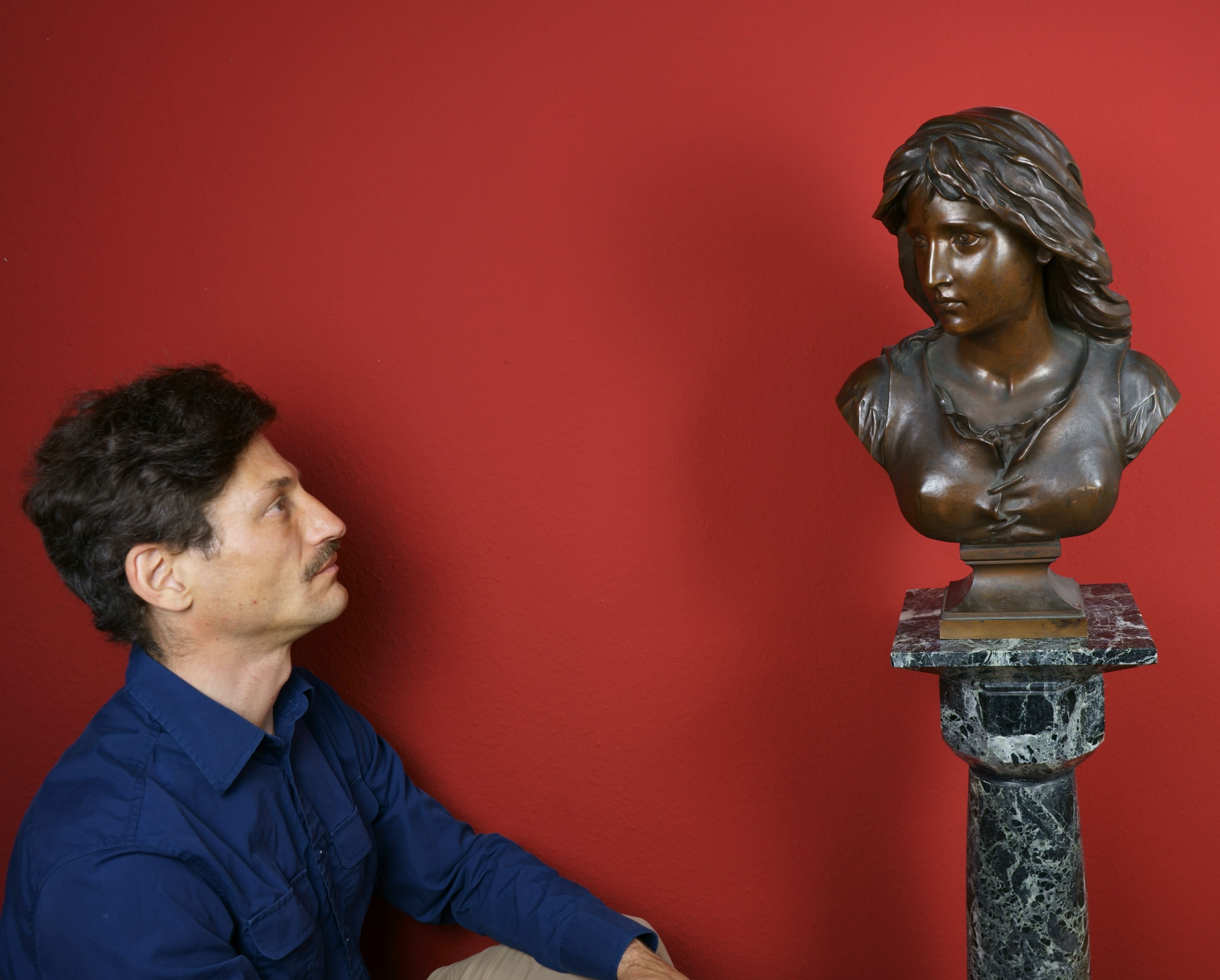
About the Seller
5.0
Gold Seller
Premium sellers maintaining a 4.3+ rating and 24-hour response times
Established in 2014
1stDibs seller since 2023
20 sales on 1stDibs
- ShippingRetrieving quote...Shipping from: Berlin, Germany
- Return Policy
Authenticity Guarantee
In the unlikely event there’s an issue with an item’s authenticity, contact us within 1 year for a full refund. DetailsMoney-Back Guarantee
If your item is not as described, is damaged in transit, or does not arrive, contact us within 7 days for a full refund. Details24-Hour Cancellation
You have a 24-hour grace period in which to reconsider your purchase, with no questions asked.Vetted Professional Sellers
Our world-class sellers must adhere to strict standards for service and quality, maintaining the integrity of our listings.Price-Match Guarantee
If you find that a seller listed the same item for a lower price elsewhere, we’ll match it.Trusted Global Delivery
Our best-in-class carrier network provides specialized shipping options worldwide, including custom delivery.More From This Seller
View AllWoodland / - The Inner Drama of the Landscape -
Located in Berlin, DE
Eduard Peithner von Lichtenfels (1833 Vienna - 1913 Berlin), Woodland, 1884. Watercolor and pen and ink on drawing paper, 30.4 cm x 22.5 cm, signed, dated and inscribed by the artist...
Category
1880s Landscape Drawings and Watercolors
Materials
Paper
Shady hollow way - Into the heart of the forest -
By Hans Dvoràk
Located in Berlin, DE
Hans Dvořák (19th century). Shady hollow way in a sunny forest. Watercolour and pen-and-ink drawing, 58.5 x 43 cm (visible size), 70 x 55.5 cm (frame), signed and dated "Hans Dvořák ...
Category
1880s Realist Landscape Drawings and Watercolors
Materials
Watercolor
$1,305 Sale Price
20% Off
Summer Forest Landscape, 1915 / - The Forest Walk -
Located in Berlin, DE
Stanislas Warnie (1879-1958), Summer Forest Landscape, 1915. Watercolor, 31.5 cm x 45 cm (passepartout), 50.5 cm x 63.5 cm (frame), signed "S. Warnie" at lower left and dated "1915"....
Category
1910s Art Nouveau Landscape Drawings and Watercolors
Materials
Watercolor
$605 Sale Price
20% Off
Forest landscape bathed in sunlight / - The Monumentality of the Forest -
Located in Berlin, DE
Wilhelm Feldmann (1859 Lüneburg - 1932 Lübeck), Sunny forest landscape, c. 1900. Oil on canvas, marouflaged on wood, 37 cm x 48 cm (inside dimensions), 42.5 cm x 53.5 cm (frame), sig...
Category
Early 1900s Impressionist Landscape Paintings
Materials
Oil
Norwegian Pine Grove - The inner glow of the trees -
Located in Berlin, DE
Themistokles von Eckenbrecher (1842 Athens - 1921 Goslar), Norwegian pine grove, 1901. Watercolor on blue-green paper, 30 x 22 cm. Signed, dated and inscribed in his own hand "TvE. Fagermes [i.e. Fagermes]. 26.6.[19]01."
- Slight crease throughout at left margin, otherwise in good condition.
About the artwork
Themistokles von Eckenbrecher often traveled to Norway to study the nature that fascinated him there. On June 26, 1901, near the southern Norwegian town of Fagernes, in the summer evening sun, he saw a small pine grove, which he immediately captured in a watercolor. He exposed the trees growing on a small hill in front of the background, so that the pines completely define the picture and combine to form a tense motif. The tension comes from the contrast of form and color. The trunks, growing upward, form a vertical structure that is horizontally penetrated by the spreading branches and the pine needles, which are rendered as a plane. This structural tension is further intensified by the color contrast between the brown-reddish iridescent trunks and branches and the green-toned needlework.
Themistokles von Eckenbrecher, however, does not use the observed natural scene as an inspiring model for a dance of color and form that detaches itself from the motif and thus treads the path of abstracting modernism. Its inner vitality is to be brought to light and made aesthetically accessible through the work of art.
It is precisely in order to depict the inner vitality of nature that von Eckenbrecher chooses the technique of watercolor, in which the individual details, such as the needles, are not meticulously worked out, but rather a flowing movement is created that unites the contrasts. The trees seem to have formed the twisted trunks out of their own inner strength as they grew, creatingthose tense lineations that the artist has put into the picture. The inner strength continues in the branches and twigs, culminating in the upward growth of the needles. At the same time, the trunks, illuminated by the setting sun, seem to glow from within, adding an almost dramatic dimension to the growing movement.
Through the artwork, nature itself is revealed as art. In order to make nature visible as art in the work, von Eckenbrecher exposes the group of trees so that they are bounded from the outside by an all-encompassing contour line and merge into an areal unity that enters into a figure-ground relationship with the blue-greenish watercolor paper. The figure-ground relationship emphasizes the ornamental quality of the natural work of art, which further enforces the artwork character of the group of trees.
With the presentation of Themistokles von Eckenbrecher's artistic idea and its realization, it has become clear that the present watercolor is not a study of nature in the sense of a visual note by the artist, which might then be integrated into a larger work context, but a completely independent work of art. This is why von Eckenbrecher signed the watercolor. In addition, it is marked with a place and a date, which confirms that this work of nature presented itself to him in exactly this way at this place at this time. At the same time, the date and place make it clear that the natural work of art has been transferred into the sphere of art and thus removed from the time of the place of nature.
About the artist
Themistocles' parents instilled a life of travel in their son, who is said to have spoken eleven languages. His father, who was interested in ancient and oriental culture, was a doctor and had married Francesca Magdalena Danelon, an Italian, daughter of the British consul in Trieste. During a stay in Athens - Gustav von Eckenbrecher was a friend of Heinrich von Schliemann and is said to have given him crucial clues as to the location of Troy - Themistokles saw the light of day in 1842.
After an interlude in Berlin, where Themistokles was educated at the English-American School, the journey began again. From 1850 to 1857 the family lived in Constantinople, after which the father opened a practice in Potsdam, where Themistokles, who wanted to become a painter, was taught by the court painter Carl Gustav Wegener.
In 1861 the von Eckenbrechers left Potsdam and settled in Düsseldorf. There Themistokles received two years of private tuition from Oswald Aschenbach, who greatly admired the talented young artist. After his artistic training, he undertook extensive travels, often accompanied by Prince Peter zu Sayn-Wittgenstein, which took him to northern and eastern Europe, but above all to the Middle East and even to South America. The paintings that resulted from these journeys established his artistic reputation and led to his participation in large panoramas such as the 118 x 15 metre Entry of the Mecca Caravan into Cairo, painted for the City of Hamburg in 1882.
1882 was also the start of a total of 21 study trips to Scandinavia, most of them to Norway, and the unique Norwegian landscape with its rugged fjords became a central motif in his work. Along with Anders Askevold and Adelsteen Normann...
Category
Early 1900s Naturalistic Landscape Drawings and Watercolors
Materials
Watercolor
$1,118 Sale Price
20% Off
At the pond / - The longing of the landscape -
Located in Berlin, DE
Hans Thoma (1839 Bernau - 1924 Karlsruhe), At the pond, 1897. Algraph on strong wove paper, published by Breitkopf und Härtel in Leipzig as ‘Zeitgenössisches Kunstblatt Nr. 148’, 23....
Category
1890s Realist Figurative Prints
Materials
Paper
You May Also Like
Hasbrucken Wald Altenberg Germany - The Forest - Dutch 19thC wooded landscape
By Cornelius Springer
Located in London, GB
A stunning large drawing, signed and dated 1880, by Cornelius Springer. It is house behind glass in a fine frame. A huge heroic Ruisdael tree empowers this picture. Beneath it, worke...
Category
19th Century Realist Landscape Drawings and Watercolors
Materials
Pencil
'Woodland Stream', Paris, New York, Hudson River School, Luminism, AIC, PAFA
By Arthur Parton
Located in Santa Cruz, CA
Signed lower right, 'Arthur Parton' (American, 1842-1914) and painted circa 1885.
This notable Hudson River School painter first studied under William Trost Richards, from whom he gained a grounding in the technical aspects of his craft, and, subsequently, at the Pennsylvania Academy of Fine Arts. While in Philadelphia, he began to exhibit with success and, in 1864, moved to New York where he continued to exhibit before leaving for Europe in 1869. In France, he was influenced by the works of the Barbizon painters and then furthered his studies in Paris and London (1870) before continuing to Scotland (1871). Upon his return to America, he would go on to establish himself as a major figure in the art world, maintaining a studio at 51 West 10th Street from 1874 to 1893.
Best known for his landscapes of the Adirondacks and Catskill Mountains, Parton also painted in England and Scotland. During his career, he explored several styles including Tonalism and Impressionism, but remained closely influenced by the Hudson River style including Luminism. Parton was a member of the American Watercolor Society, the Artists Fund Society and, from 1871, the National Academy of Design, becoming a National Academician in 1884. Parton exhibited widely and with success including at the Corcoran Gallery of Art (1907-1908, 1910), Brooklyn Artists Association (1866-85), Philadelphia Centennial Exposition (1876), Boston Art Club (1882-1909), New York City (1886 gold medal), Pennsylvania Academy of Fine Arts (1889 Temple gold medal, 1891, 1896-97, 1905), Paris Exposition Universelle (1889 honorable mention), St Louis Exposition (1904 medal), the Art Institute of Chicago and, for more than 50 years, at the National Academy of Design (1862-1914, 1896 prize).
Parton gained widespread recognition after his painting of the Shenandoah River (1872) was published in William Cullen Bryant...
Category
1880s Hudson River School Landscape Drawings and Watercolors
Materials
Paper, Watercolor, Gouache, Postcard
Forest - Watercolor by French Master - Mid 20th Century
Located in Roma, IT
Trees of Forest is an original painting in watercolor by an anonymous French Master of the XX century. The state of preservation is good and aged with si...
Category
Mid-20th Century Figurative Drawings and Watercolors
Materials
Watercolor
Rudolf Höckner, Forest Landscape. Hamburg, Wedel, Germany. Oil on canvas.
Located in Berlin, DE
Rudolf Höckner, Forest Landscape. Hamburg, Wedel, Germany. Oil on canvas.
Dimensions with frame in cm 63 x 82.5
Category
20th Century Landscape Paintings
Materials
Canvas, Oil
$3,728 Sale Price
20% Off
Free Shipping
W. Hinchcliff - Late 19th Century Watercolour, Forest Scene with a Pond
Located in Corsham, GB
A fine and carefully detailed landscape view of a forest, with a small pond and a wooden bridge leading down a wooded path, by the artist W. Hinchliff. The artist has added texture t...
Category
19th Century Landscape Drawings and Watercolors
Materials
Watercolor
$292 Sale Price
20% Off
Autumn Forest - Oil on plate by Gerhard Haenisch - 19th Century
Located in Roma, IT
Autumn Forest is an original old masters artwork realized by Gerhard Haenisch in the 19th Century.
Original oil on plate. On the back another motif with a landscape and a house view...
Category
19th Century Modern Landscape Prints
Materials
Oil
